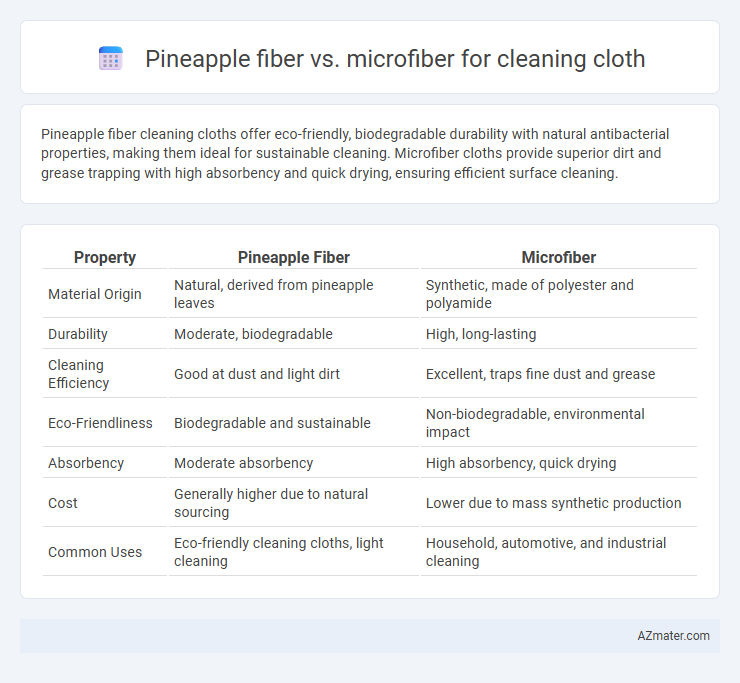Pineapple fiber cleaning cloths offer eco-friendly, biodegradable durability with natural antibacterial properties, making them ideal for sustainable cleaning. Microfiber cloths provide superior dirt and grease trapping with high absorbency and quick drying, ensuring efficient surface cleaning.
Table of Comparison
| Property | Pineapple Fiber | Microfiber |
|---|---|---|
| Material Origin | Natural, derived from pineapple leaves | Synthetic, made of polyester and polyamide |
| Durability | Moderate, biodegradable | High, long-lasting |
| Cleaning Efficiency | Good at dust and light dirt | Excellent, traps fine dust and grease |
| Eco-Friendliness | Biodegradable and sustainable | Non-biodegradable, environmental impact |
| Absorbency | Moderate absorbency | High absorbency, quick drying |
| Cost | Generally higher due to natural sourcing | Lower due to mass synthetic production |
| Common Uses | Eco-friendly cleaning cloths, light cleaning | Household, automotive, and industrial cleaning |
Introduction to Pineapple Fiber and Microfiber
Pineapple fiber, derived from the leaves of the pineapple plant, is a sustainable and biodegradable material gaining popularity for eco-friendly cleaning cloths due to its natural durability and softness. Microfiber, composed of synthetic polyester and polyamide fibers, offers superior absorption and trapping of dust and dirt, making it highly effective for cleaning surfaces without chemicals. Both materials serve distinct purposes: pineapple fiber emphasizes environmental sustainability, while microfiber excels in high-performance cleaning efficiency.
Production Process of Pineapple Fiber
The production process of pineapple fiber involves extracting fibers from the leaves of the pineapple plant through a method called decortication, which separates the long, strong fibers from the leaf pulp. These natural fibers undergo cleaning, drying, and combing to create a soft, durable fabric ideal for eco-friendly cleaning cloths. Compared to synthetic microfiber, pineapple fiber offers sustainable production with minimal chemical use, enhancing its environmental appeal for cleaning applications.
Manufacturing Microfiber: An Overview
Manufacturing microfiber involves blending polyester and polyamide fibers with diameters finer than one denier, resulting in dense, highly absorbent textiles ideal for cleaning. These ultra-fine fibers provide superior dirt and grease removal by trapping particles more effectively than natural fibers like pineapple fiber, which is derived from pineapple leaf waste and features longer, coarser strands. Microfiber's synthetic composition allows for uniform production and enhanced durability, making it a preferred material in high-performance cleaning cloths.
Environmental Impact: Pineapple Fiber vs Microfiber
Pineapple fiber, derived from sustainable agricultural waste, offers a biodegradable and eco-friendly alternative to synthetic microfiber, which is primarily made from non-renewable petroleum-based materials. Microfiber contributes to microplastic pollution due to its synthetic composition and shedding during washing, while pineapple fiber decomposes naturally without releasing harmful pollutants. Choosing pineapple fiber cleaning cloths significantly reduces environmental impact by minimizing waste and promoting renewable resource use.
Durability and Longevity in Cleaning Applications
Pineapple fiber exhibits superior durability and longevity compared to microfiber in cleaning cloth applications due to its natural toughness and resistance to wear over repeated uses. Microfiber, while soft and effective for delicate surfaces, tends to degrade faster with frequent washing and exposure to harsh cleaning chemicals. The cellulose-rich structure of pineapple fiber ensures sustained performance and eco-friendly decomposition, making it a more resilient choice for long-term cleaning tasks.
Absorbency and Performance Comparison
Pineapple fiber exhibits superior absorbency due to its natural lignin and cellulose structure, enabling it to retain moisture effectively during cleaning tasks. Microfiber, composed of ultra-fine synthetic fibers, offers exceptional performance by trapping dirt and dust particles through its densely woven structure, providing quick drying and streak-free results. Comparing both, pineapple fiber excels in eco-friendly moisture absorption, while microfiber outperforms in durability and precision cleaning efficiency.
Cost and Availability Analysis
Pineapple fiber cleaning cloths offer a sustainable, biodegradable option but tend to be costlier due to limited production and niche availability. Microfiber cloths are widely available and more affordable, benefiting from large-scale manufacturing and extensive distribution networks. The cost-efficiency and accessibility of microfiber make it a preferred choice for everyday cleaning tasks, while pineapple fiber suits eco-conscious consumers seeking premium, natural materials.
Hypoallergenic and Health Considerations
Pineapple fiber cleaning cloths are naturally hypoallergenic and antimicrobial, making them ideal for sensitive skin and environments requiring high hygiene standards. Microfiber cloths, while effective at trapping dirt, can sometimes retain allergens and harbor bacteria if not washed properly. Choosing pineapple fiber reduces the risk of allergic reactions and promotes healthier cleaning by minimizing chemical residues and synthetic material exposure.
Best Uses for Each Type of Cleaning Cloth
Pineapple fiber cleaning cloths excel in eco-friendly cleaning tasks, offering natural antibacterial properties ideal for dusting and wiping delicate surfaces without causing scratches. Microfiber cloths provide superior absorbency and durability, making them perfect for heavy-duty cleaning, removing grease, and polishing glass or mirrors to a streak-free finish. Choosing pineapple fiber suits sustainable, light cleaning needs whereas microfiber is best for versatile, high-performance cleaning applications.
Conclusion: Choosing Between Pineapple Fiber and Microfiber
Pineapple fiber offers an eco-friendly, biodegradable alternative to synthetic microfiber, making it ideal for sustainable cleaning solutions. Microfiber excels in durability, absorbency, and fine particle removal, providing superior cleaning efficiency and longevity. Selecting between pineapple fiber and microfiber depends on prioritizing environmental impact versus cleaning performance and durability.

Infographic: Pineapple fiber vs Microfiber for Cleaning cloth
 azmater.com
azmater.com